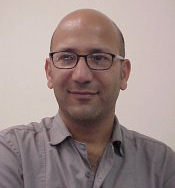Dr. Mehdi M. Dastani
The MIT Technology Review article An Emotional Cat Robot: Robots might behave more efficiently if they had emotions said
“Scientists in the Netherlands are endowing a robotic cat with a set of logical rules for emotions. They believe that by introducing emotional variables to the decision-making process, they should be able to create more-natural human and computer interactions.‘We don’t really believe that computers can have emotions, but we see that emotions have a certain function in human practical reasoning,’ says Mehdi Dastani, an artificial-intelligence researcher at Utrecht University, in the Netherlands. By bestowing intelligent agents with similar emotions, researchers hope that robots can then emulate this human-like reasoning, he says.
Dastani’s emotional functions have been derived from a psychological model known as the OCC model, devised in 1988 by a trio of psychologists: Andrew Ortony and Allan Collins, of Northwestern University, and Gerald Clore, of the University of Virginia. ‘Different psychologists have come up with different sets of emotions,’ says Dastani. But his group decided to use this particular model because it specified emotions in terms of objects, actions, and events.”
Mehdi M. Dastani, Ph.D. is lecturer at the Intelligent Systems Group of Utrecht university. His research focus is agent theories and agent applications, in particular the topic of specification and implementation languages for cognitive agents. His projects include CoCoMAS: Coordination and Composition in Multi-Agent Systems (Principle Investigator), 3APL: An Abstract Agent Programming Language, BOID: A Cognitive Agent Architecture, and Visual Perception.
Mehdi coedited Multi-Agent Programming: Languages, Platforms and Applications and Programming Multi-Agent Systems: First International Workshop, PROMAS 2003, Melbourne, Australia, July 15, 2003, Selected Revised and Invited Papers, and coauthored What is a normative goal?, Role-assignment in open agent societies, A Programming Language for Cognitive Agents Goal Directed 3APL, Modelling user preferences and mediating agents in electronic commerce, and The BOID architecture: conflicts between beliefs, obligations, intentions and desires. Read his full list of publications!
His previous research project was A Methodology for Agent-Oriented Software Design. From 01/01/1999 until 01/08/2001 he worked on a project at the department of Artificial Intelligence at the Vrije Universiteit Amsterdam. He has studied computer science and philosophy at University of Amsterdam, and earned a Ph.D. in formal analysis of visual perception and information visualization in 1998. His Ph.D. thesis was Languages of Perception and it was published in the Institute for Logic, Language and Computation (ILLC) dissertation series.
